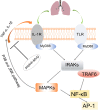Cellular Toxicity and Immunological Effects of Carbon-based Nanomaterials
- PMID: 30975174
- PMCID: PMC6460856
- DOI: 10.1186/s12989-019-0299-z
Cellular Toxicity and Immunological Effects of Carbon-based Nanomaterials
Abstract
Background: Carbon nanomaterials are a growing family of materials featuring unique physicochemical properties, and their widespread application is accompanied by increasing human exposure.
Main body: Considerable efforts have been made to characterize the potential toxicity of carbon nanomaterials in vitro and in vivo. Many studies have reported various toxicology profiles of carbon nanomaterials. The different results of the cytotoxicity of the carbon-based materials might be related to the differences in the physicochemical properties or structures of carbon nanomaterials, types of target cells and methods of particle dispersion, etc. The reported cytotoxicity effects mainly included reactive oxygen species generation, DNA damage, lysosomal damage, mitochondrial dysfunction and eventual cell death via apoptosis or necrosis. Despite the cellular toxicity, the immunological effects of the carbon-based nanomaterials, such as the pulmonary macrophage activation and inflammation induced by carbon nanomaterials, have been thoroughly studied. The roles of carbon nanomaterials in activating different immune cells or inducing immunosuppression have also been addressed.
Conclusion: Here, we provide a review of the latest research findings on the toxicological profiles of carbon-based nanomaterials, highlighting both the cellular toxicities and immunological effects of carbon nanomaterials. This review provides information on the overall status, trends, and research needs for toxicological studies of carbon nanomaterials.
Keywords: Carbon nanomaterial; Cytotoxicity; Immunological effects; Macrophage.
Conflict of interest statement
Ethics approval and consent to participate
Not applicable.
Consent for publication
Not applicable.
Competing interests
The authors declare that they have no competing interests.
Publisher’s Note
Springer Nature remains neutral with regard to jurisdictional claims in published maps and institutional affiliations.
Figures




References
-
- Hurt RH, Monthioux M, Kane A. Toxicology of carbon nanomaterials: Status, trends, and perspectives on the special issue. Carbon. 2006;44(6):1028–1033. doi: 10.1016/j.carbon.2005.12.023. - DOI
Publication types
MeSH terms
Substances
LinkOut - more resources
Full Text Sources

